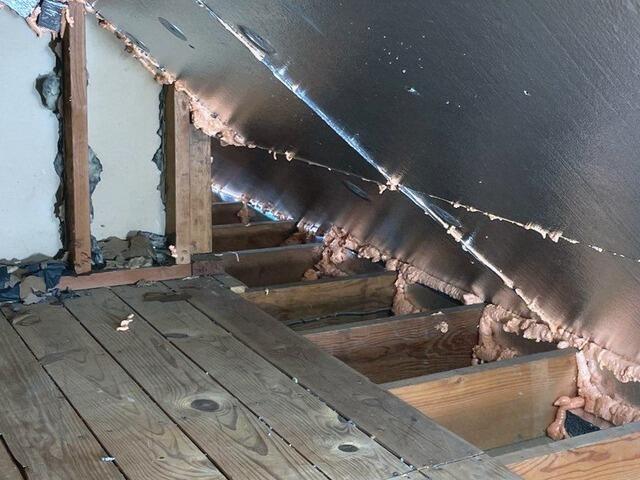Serving Jersey Shore, Middletown, Rumson, Manasquan, Brick, Colts Neck, Howell, Holmdel
Dave Hoh's Home Comfort & Energy Experts Before & After Photos
Click on a photo to enlarge.
Attic insulation Installed in Neptune, NJ
The before picture shows an attic knee wall in Neptune, NJ. This is typical in Bi-level homes. The original insulation provided no effective insulating value and no air sealing, allowing air to move through the assembly. This caused very cold and hot walls in the conditioned space adjacent. The after picture shows the same walls sheathed with 2" R-13 foam board, with all the seams sealed airtight. The result is approx R-21 performance and now the walls are not cold and hot.
Attic insulation in Neptune, NJ
Before pictures shows an attic in Neptune, NJ with some scattered plywood used for storage and no insulation.
The after picture shows several key items:#1 a properly installed insulated storage deck with insulation retaining dams, #2 approx 17" R-60+ cellulose insulation installed after attic plane air sealing and #3 A range vent hood terminated to the exterior. This home is much more comfortable and energy efficient.
Cellulose Wall Dense Pack in Neptune, NJ
This customer in Neptune, NJ recently decided to undergo total interior renovations, this included calling Dr. Energy Saver for insulation solutions. Through educating the customer on cellulose, he was able to make an informed decision on how to effectively insulate his home. Since the wall frames were already exposed, it made it easy for us to access the framing rather than having to cut holes in the sheetrock. To keep the cellulose in place and to ensure that it is densely packed, we covered the framing system in a thin netting. This allowed the cellulose to remain in place until the interior wall renovations are completed, then sheetrock will be placed over the frame and cellulose.
Boost Comfort with Attic Insulation in Neptune, NJ
In Neptune, NJ, a homeowner experienced uncomfortable temperature fluctuations in their home. During our free home evaluation, we discovered inadequate insulation in the attic. Further inspection revealed the attic floor lacked air sealing. Our team promptly addressed these issues by air sealing the attic, installing baffle vents for proper ventilation, and adding TruSoft cellulose insulation to achieve optimal R-60 levels. As a result, the homeowner now enjoys a more comfortable environment with stable temperatures and reduced energy bills.
Second-Floor Comfort Restored with Super Kneewall Insulation in Neptune, NJ
In Neptune, NJ, a homeowner struggled with second-floor rooms that were too hot in the summer and too cold in the winter. During our free home evaluation, we found poorly insulated kneewalls that let cold air leak in during winter and allowed radiant heat to enter in summer. This left the rooms uncomfortable and the storage space unusable. To solve the problem, we built a Super Kneewall by installing SilverGlo foam boards between the attic joist bays, sealing air leaks and preventing cold floors. We then added SilverGlo foam boards under the rafters with a radiant barrier that reflects heat away in summer and holds warmth in during winter. The result was proper insulation, consistent comfort, improved energy efficiency, and usable storage space.
our service area
We serve the following areas
- Allenhurst
- Allenwood
- Asbury Park
- Atlantic Highlands
- Avon By The Sea
- Belmar
- Bradley Beach
- Brick
- Brielle
- Colts Neck
- Deal
- Eatontown
- Fair Haven
- Farmingdale
- Fort Monmouth
- Highlands
- Holmdel
- Howell
- Leonardo
- Lincroft
- Little Silver
- Long Branch
- Manasquan
- Mantoloking
- Middletown
- Monmouth Beach
- Neptune
- Oakhurst
- Ocean Grove
- Oceanport
- Point Pleasant Beach
- Red Bank
- Rumson
- Sea Girt
- Shrewsbury
- Spring Lake
- Toms River
- West Long Branch











